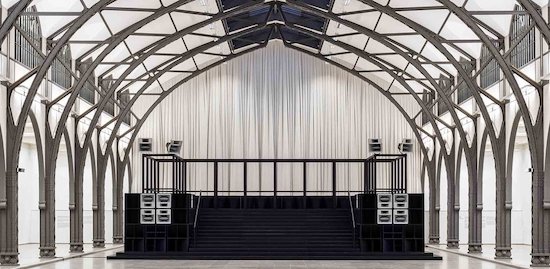Cevdet Erek, Bergama Stereo, Exhibition View, 2019 © Cevdet Erek / Staatliche Museen zu Berlin, Nationalgalerie / Photo: Mathias Völzke
According to Xenophanes, the Gigantomachy was not considered a suitable topic for discussion at the dinner table. Like sex or politics, it was thought too vulgar or too prone to controversy; a threat to good digestive processes. But it was a frequent subject of classical art.
No-one now knows why the giants started on the Olympian gods. But it is said that as soon as they were born they began hurling clods of earth and tree trunks up at the sky. Ovid pictures them piling mountains upon other mountains in order to storm the heavens and break into the palaces of the gods. A populist revolt, fought with the very earth itself.
Borne of Gaia herself, they could not be killed by the gods alone – like today’s best chess computers, only an alliance between gods and mortals could beat them. So Zeus summoned Heracles and the giants were slain, one by one, cut down by the former’s lightning bolts and the latter’s bow and arrow. But as their blood mingled with the soil of the battlefield, there rose a new race – of humans.
There are over 600 representations of this epic struggle catalogued in the Lexicon Iconographicum Mythologiae Classicae. You can see it depicted on Attic vases from as early as the 6th century BC, on the walls of the treasury at Delphi and the Temple of Apollo, and on the east façade of the Parthenon. Perhaps most strikingly, the Gigantomachy is the subject of the 113 metre long marble frieze decorating the Pergamon Altar.
When this Altar was constructed, the Pergamene Kingdom, northwest of the modern city of Bergama, Turkey, had only recently gained its independence. No longer a vassal to the empires of Seleucia, Persia or Thrace, the construction of this vast monument is today thought to be a tribute to that newfound autonomy, an attempt to shore up its authority and cement its unique identity.
When the German engineer Carl Humann begun its excavation in 1878, the German Empire had only recently completed its own Gigantomachy, after victory in the Franco-Prussian War, and declared its own autonomy and unification. Despite unease on the part of the archaeologists about removing the monument from its original location, the Altar was brought to Berlin and ultimately, in 1910, given its own museum, where it remains to this day.
In September 2014, it was announced that the Pergamon Museum would close to the public for renovations for five years. In 2016 it was announced that the Altar would not be accessible to the public again until 2023. But in 2019, Turkish artist Cevdet Erek brought the Pergamon Altar three kilometres north-west to the Hamburger Bahnhof – Museum für Gegenwart, near Berlin’s central station. Not the original. Even in the vast former train shed of the museum’s north-facing hall, the Altar’s vast proportions, 35.64 metres by 33.4 metres, would feel cramped and hemmed in. Erek’s Bergamo Stereo is a 2:1 scale reproduction, rebuilt as a matt-black architectural installation of loudspeaker casings. The famous Gigantomachy frieze itself is gone, replaced by what Erek calls an “acoustic frieze”, a wall of noise pounding out of thirty-four separate channels. This is a Gigantomachy wrought in sound, a temple as nightclub.
Rending space as sound and sound as space has long been Erek’s thing. As a student at Istanbul’s Mimar Sinan University of Fine Arts, he graduated with a degree in architecture in 1999, following that up with postgraduate studies in sound engineering and design. When I interviewed the artist for this parish back in 2017, when he was preparing to fill the Turkish Pavilion at Venice, he spoke of his work in terms of an attempt to “come up with a new language” for talking about space, place, and sound. “The work that I’m doing, “ he told me, “is mostly trying to find a solution to a spatial problem.” Bergamo Stereo, in a sense, is just that – how to reduce the scale of the original altar, without losing its force, its monumentality.
He’s given us the Pergamon Altar as rig, inviting us to think of sound itself as something massed, something sculptural, even majestic. And it’s a real sonic edifice, this thing, pounding and relentless. It expands to fill the space of the hall, with a dozen odd stalls dotted about the room – some near, some far, in front or behind – inviting gallery visitors to take up different positions in respect to it. You can stay close and zoom in on small details of the sound, like the syncopated ride cymbals coming from the speakers on the sides of the steps or the dinky motif of electronic blips issuing from the back side, or hang back and let the ambience of the room almost take over, transforming the looping composition into a great thudding soup of noise.
Together, it becomes something machinic, like a train or factory floor, but also primeval, ritualistic, drawing out links between the ritual sacrifices once carried out on this altar millennia ago and the hedonistic rites of modern clubbing. Best of all perhaps, is the way it allows its audience to take part in it, to explore and inhabit the installation in different ways – whether walking up its great steps and strolling the ramparts or simply hanging out, lounging on the floor in its presence, to socialise and relax, as several people were when I visited the installation. Heavy as this thing is, it doesn’t require your obeisance. It’s big enough and mighty enough on its own not to need it.
Cevdet Erek, Bergama Stereo, is at Hamburger Bahnhof – Museum für Gegenwart until 8 March 2020


